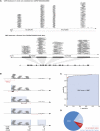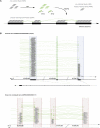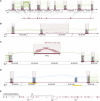mRNA-seq with agnostic splice site discovery for nervous system transcriptomics tested in chronic pain
- PMID: 20452967
- PMCID: PMC2877581
- DOI: 10.1101/gr.101204.109
mRNA-seq with agnostic splice site discovery for nervous system transcriptomics tested in chronic pain
Abstract
mRNA-seq is a paradigm-shifting technology because of its superior sensitivity and dynamic range and its potential to capture transcriptomes in an agnostic fashion, i.e., independently of existing genome annotations. Implementation of the agnostic approach, however, has not yet been fully achieved. In particular, agnostic mapping of pre-mRNA splice sites has not been demonstrated. The present study pursued dual goals: (1) to advance mRNA-seq bioinformatics toward unbiased transcriptome capture and (2) to demonstrate its potential for discovery in neuroscience by applying the approach to an in vivo model of neurological disease. We have performed mRNA-seq on the L4 dorsal root ganglion (DRG) of rats with chronic neuropathic pain induced by spinal nerve ligation (SNL) of the neighboring (L5) spinal nerve. We found that 12.4% of known genes were induced and 7% were suppressed in the dysfunctional (but anatomically intact) L4 DRG 2 wk after SNL. These alterations persisted chronically (2 mo). Using a read cluster classifier with strong test characteristics (ROC area 97%), we discovered 10,464 novel exons. A new algorithm for agnostic mapping of pre-mRNA splice junctions (SJs) achieved a precision of 97%. Integration of information from all mRNA-seq read classes including SJs led to genome reannotations specifically relevant for the species used (rat), the anatomical site studied (DRG), and the neurological disease considered (pain); for example, a 64-exon coreceptor for the nociceptive transmitter substance P was identified, and 21.9% of newly discovered exons were shown to be dysregulated. Thus, mRNA-seq with agnostic analysis methods appears to provide a highly productive approach for in vivo transcriptomics in the nervous system.
Figures




Similar articles
-
Brain-derived neurotrophic factor increases in the uninjured dorsal root ganglion neurons in selective spinal nerve ligation model.J Neurosci. 2001 Jul 1;21(13):4891-900. doi: 10.1523/JNEUROSCI.21-13-04891.2001. J Neurosci. 2001. PMID: 11425916 Free PMC article.
-
Change in mRNAs for neuropeptides and the GABA(A) receptor in dorsal root ganglion neurons in a rat experimental neuropathic pain model.Pain. 1998 Oct;78(1):13-26. doi: 10.1016/S0304-3959(98)00111-0. Pain. 1998. PMID: 9822208
-
Upregulation of Cav3.2 T-type calcium channels in adjacent intact L4 dorsal root ganglion neurons in neuropathic pain rats with L5 spinal nerve ligation.Neurosci Res. 2019 May;142:30-37. doi: 10.1016/j.neures.2018.04.002. Epub 2018 Apr 21. Neurosci Res. 2019. PMID: 29684385
-
A comparison of RNA-seq and exon arrays for whole genome transcription profiling of the L5 spinal nerve transection model of neuropathic pain in the rat.Mol Pain. 2014 Jan 28;10:7. doi: 10.1186/1744-8069-10-7. Mol Pain. 2014. PMID: 24472155 Free PMC article.
-
Expression of brain-derived neurotrophic factor in rat dorsal root ganglia, spinal cord and gracile nuclei in experimental models of neuropathic pain.Neuroscience. 2001;107(2):301-9. doi: 10.1016/s0306-4522(01)00353-0. Neuroscience. 2001. PMID: 11731104
Cited by
-
Using a priori knowledge to align sequencing reads to their exact genomic position.Nucleic Acids Res. 2012 Sep;40(16):e125. doi: 10.1093/nar/gks393. Epub 2012 May 11. Nucleic Acids Res. 2012. PMID: 22581774 Free PMC article.
-
Phospholipase C δ4 regulates cold sensitivity in mice.J Physiol. 2016 Jul 1;594(13):3609-28. doi: 10.1113/JP272321. Epub 2016 May 29. J Physiol. 2016. PMID: 27062607 Free PMC article.
-
Circadian regulation of chemotherapy-induced peripheral neuropathic pain and the underlying transcriptomic landscape.Sci Rep. 2020 Aug 14;10(1):13844. doi: 10.1038/s41598-020-70757-w. Sci Rep. 2020. PMID: 32796949 Free PMC article.
-
Analgesia by inhibiting tetrahydrobiopterin synthesis.Curr Opin Pharmacol. 2012 Feb;12(1):92-9. doi: 10.1016/j.coph.2011.10.019. Epub 2011 Dec 15. Curr Opin Pharmacol. 2012. PMID: 22178186 Free PMC article. Review.
-
DGEclust: differential expression analysis of clustered count data.Genome Biol. 2015 Feb 20;16(1):39. doi: 10.1186/s13059-015-0604-6. Genome Biol. 2015. PMID: 25853652 Free PMC article.
References
Publication types
MeSH terms
Substances
Associated data
- Actions
Grants and funding
LinkOut - more resources
Full Text Sources
Other Literature Sources
Medical
Molecular Biology Databases
Miscellaneous
